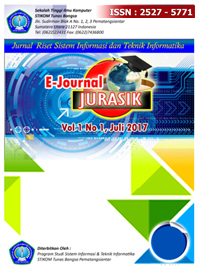Analisis Metode Naive Bayes dalam Memprediksi Tingkat Pemahaman Mahasiswa Terhadap Mata Kuliah Berdasarkan Posisi Duduk
Abstract
Full Text:
PDFReferences
C. Fadlan, S. Ningsih, and A. P. Windarto, “PENERAPAN METODE NAÏVE BAYES DALAM KLASIFIKASI KELAYAKAN KELUARGA PENERIMA BERAS RASTRA,” JUTIM, vol. 3, no. 1, pp. 1–8, 2018.
S. Haryati, A. Sudarsono, and E. Suryana, “Implementasi Data Mining untuk Memprediksi Masa Studi Mahasiswa Menggunakan Algoritma C4.5,” Jurnal Media Infotama, vol. 11, no. 2, pp. 130–138, 2015.
E. Manalu and F. A. S. M. R. Manalu, “PENERAPAN ALGORITMA NAIVE BAYES UNTUK MEMPREDIKSI JUMLAH PRODUKSI BARANG BERDASARKAN DATA PERSEDIAAN DAN JUMLAH PEMESANAN PADA CV . PAPADAN MAMA PASTRIES,” Jurnal Mantik Penusa, vol. 1, no. 2, 2017.
I. Parlina, A. P. Windarto, A. Wanto, and M. R. Lubis, “Memanfaatkan Algoritma K-Means dalam Menentukan Pegawai yang Layak Mengikuti Asessment Center untuk Clustering Program SDP,” CESS (Journal of Computer Engineering System and Science), vol. 3, no. 1, pp. 87–93, 2018.
M. G. Sadewo, A. P. Windarto, and A. Wanto, “Penerapan Algoritma Clustering dalam Mengelompokkan Banyaknya Desa/Kelurahan Menurut Upaya Antisipasi/ Mitigasi Bencana Alam Menurut Provinsi dengan K-Means,” KOMIK (Konferensi Nasional Teknologi Informasi dan Komputer), vol. 2, no. 1, pp. 311–319, 2018.
S. Sudirman, A. P. Windarto, and A. Wanto, “Data Mining Tools | RapidMiner : K-Means Method on Clustering of Rice Crops by Province as Efforts to Stabilize Food Crops In Indonesia,” IOP Conference Series: Materials Science and Engineering, vol. 420, no. 12089, pp. 1–8, 2018.
R. W. Sari, A. Wanto, and A. P. Windarto, “Implementasi Rapidminer dengan Metode K-Means (Study Kasus : Imunisasi Campak pada Balita Berdasarkan Provinsi),” KOMIK (Konferensi Nasional Teknologi Informasi dan Komputer), vol. 2, no. 1, pp. 224–230, 2018.
A. N. Putri, “PENERAPAN NAIVE BAYESIAN UNTUK PERANKINGAN KEGIATAN DI FAKULTAS TIK UNIVERSITAS SEMARANG,” Jurnal SIMETRIS, vol. 8, no. 2, pp. 603–610, 2017.
L. Krissadi and G. Sekar, “HUBUNGAN LETAK TEMPAT DUDUK DENGAN PENCAPAIAN NILAI AKHIR BLOK MAHASISWA FAKULTAS KEDOKTERAN UMM ANGKATAN 2008 Alpha Cronbach Hasil Reliabel,” no. 2003, pp. 18–21, 2012.
DOI: http://dx.doi.org/10.30645/senaris.v1i0.48
Refbacks
- There are currently no refbacks.
 








